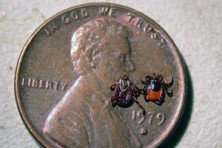Gene Switches and the Spread of Lyme Disease
- Share
- Tweet
- Pin
- Share
• People have about the same number of genes as lab mice (40,000), and almost every human gene has a counterpart in the mouse genome. So why don’t we look or behave more like mice? The answer lies in the number of molecular “switches” known to regulate the expression of our 20,000-odd protein coding genes. Proteins provide the scaffolding of the body (e.g., muscle, skin, etc.), but more important, the enzymes that drive millions of chemical reactions are made of proteins. Literally, proteins are the stuff of life. In contrast to mouse genes, human genes can be expressed in a multitude of ways by a tremendous number of controlling elements, which function as genetic “switches.” Some of these controlling switches merely involve adding a small molecule to a gene to change the way it is expressed, other switches involve bits of DNA that can modify genes. It is estimated that there are about 4 million switches available to modify the expression of our genes, and some of these switches are enabled by our environment. (The Economist, Sept. 8, 2012)
• Lyme disease has increased substantially in the U.S. over the past 30 years. One theory suggests that an increase in the size of deer herds is the cause, for they are hosts for ticks that carry the disease-causing bacteria. However, researchers recently found that the incidence of Lyme disease in Wisconsin and several other states seems to be correlated with the scarcity of red foxes, which are major predators of mice and other rodents on which young ticks feed and acquire Lyme-causing bacteria. This suggests that foxes and other rodent-eating mammals, including coyotes, also represent links in the spread of Lyme disease. (Science, June 22, 2012)
• A heat wave, probably the most extreme in the last 100 years, swept over the ice-capped island of Greenland in July of this year. About 97 percent of the surface became slush temporarily, even at the island’s highest and coldest point. Richard Alley, a glaciologist at Penn State University, said the following about the discovery: “Nature could have caused this melt even by chance. But humans made it more likely with greenhouse gases.” (Science News, Aug. 25, 2012)
• About 500 families worldwide carry three genes for early onset Alzheimer’s Disease (AD), which occurs when a person is around 50 years old. A defect in these genes can result in the accumulation of insoluble amyloid protein (AP) masses that begin to kill or crowd neurons to the point where mental function begins to diminish. Several studies suggest that changes occur in the brain long before signs of mental loss. For example, it was discovered that the amount of AD-related protein fragments in cerebrospinal fluid dropped a number of years before AD symptoms occurred. It appeared that these fragments were removed from spinal fluid to become concentrated in the brain as AP masses, leading to dementia. Today scientists are beginning clinical trials on members of susceptible families before there are signs of mental loss. Several promising drugs will be tested in the trials. (Science, Aug. 17, 2012)

